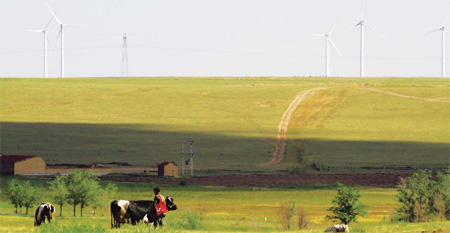-
News >Bizchina
Green energy powers grasslands
2010-11-24 15:08
Wind-powered generators dot the vast grassland in Xilin Gol league, which is in the middle of the Inner Mongolia autonomous region. [Photo / China Daily]
Power potentialResults of an extensive national survey by the China Meteorological Administration show wind resources are mainly concentrated in northwestern and northern parts of China.
Xilin Gol, one of the country's most northern points, endures six months of windy winters. Thanks to recurrent airstreams in spring and winter, winds as strong as 17 meters per second also sweep the area 60 to 80 days out of the year.
In a way, the relatively steady wind - an average of 3 to 11 m/s - is a blessing, making a large proportion of the prefecture a natural base for wind farms.
A series of studies conclude that the blustery conditions have the potential to generate at least 50 million kW of electricity, with more than 10 possible sites for large facilities with capacities of 1 million kW.
Xilin Gol has abundant land with open grassland and sandy soil, and is sparsely populated, with five people per square kilometer. It is hard not to be impressed with the spectacular sight of hundreds of wind turbines on its plains and meandering hills.
At the end of this year, about 31 wind farms with capacities to produce 2 million kW a year will have been completed, generating 5 billion kW, said Yu at the local development and reform commission.
And by 2020, the prefecture is expected to have 100, with a combined rolling capacity of 11.2 million kW, according to a tentative plan drafted by the commission.
However, Yu admitted the intermittent nature of wind means it is not a continuous and steady power resource.
In the control room at Shenhua Guohua (Xinlin Gol) Renewable Energy one recent rainy afternoon, the only figure on the computer monitors was zero. The wind speed was too mild to get its turbines at Huitengliang moving.
"We were able to send out between 30,000 to 40,000 kW of electricity this morning," explained general manager Wang Wenguo apologetically. He also started his career installing small turbines at herders' yurts.
The wind is relatively mild in summer, too; although Yu insisted it is also when the sunshine is the strongest, providing the best source for solar energy.
Sunshine in Xilin Gol ranges between 2,088 and 3,290 hours a year, with the solar radiation enough to generate the same heat as 29.8 billion tons of standard coal.
Preliminary work is being conducted and the prefecture hopes to be able to build five solar power stations with a combined capacity of 5 million kW on its deserts, according to the local plan that is awaiting approval from the Energy Bureau of the National Development and Reform Commission.
Other resources
Once ranked first in Inner Mongolia in terms of average per capita income, Xilin Gol now lags behind Erdos, which has risen as one of the wealthiest areas in China for tapping its coal resources.Yet, Xilin Gol has the second largest coal reserve in Inner Mongolia - 144.8 billion tons - and has China's largest reserves of lignite, also known as brown coal.
Experts have found at least five mines with reserves of at least 10 billion tons of brown coal, which is the lowest rank of coal but also low in sulfur and phosphorous. In the developed countries, it is used almost exclusively as fuel for electric power generation.
Moreover, the coal is invariably deposited close to the surface, making it commercially viable to extract with open-pit mining. In fact, the national and regional development and reform commissions have already approved 12 mine projects in Xilin Gol, with production set to reach 100 million tons this year. Four of the pits are major projects under the 11th Five Year Plan (2006-2010).
Yu and his colleagues have also proposed that at least four major power plants are built beside or close to the mines to save on the amount of diesel used in transport, as well as other materials used in road construction, and thereby reducing the overall carbon footprint. "Sending electricity inland is more economical and leaves fewer carbon footprint than transporting coal down south," he said.
At the Shangdu power plant, where coal arrives by train from an open-pit mine 213 km away, many new technologies have helped to make it green. It is equipped with an advanced desulphurization process to reduce pollution and a dry cooling system imported from Germany to reduce water use by 80 percent.
With four 600,000-kW units already in operation, the plant accounts for roughly 78 percent of all electricity generated in Xilin Gol and sends the power directly to grids covering Beijing, Tianjin and the city of Tangshan in Hebei province.
"We're proud we help maintain the steady supply of electricity in our nation's capital," said Bian Guangping, the plant's deputy general. "We won a national award for our contribution to the Beijing Olympics in 2008."
